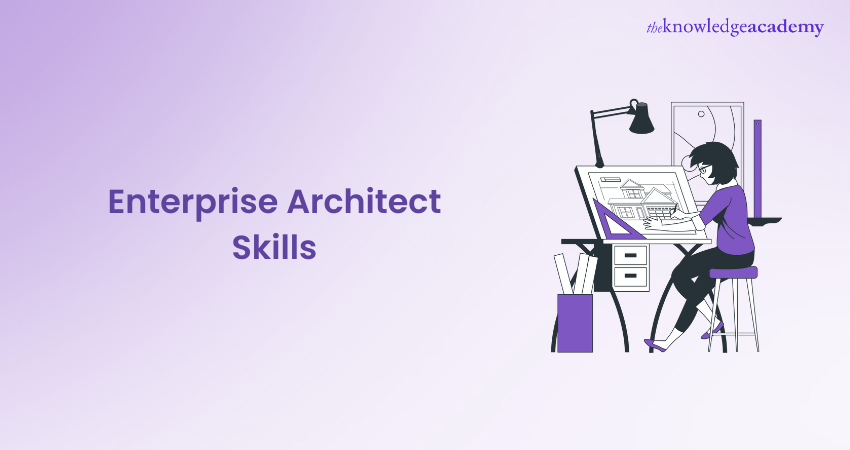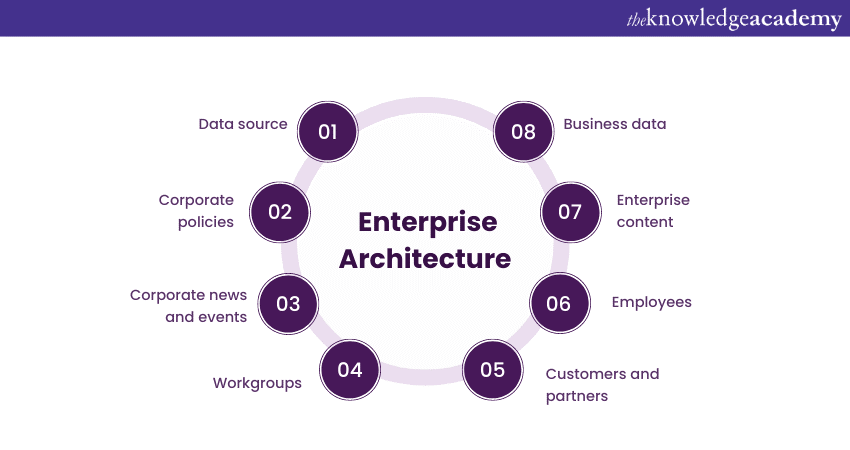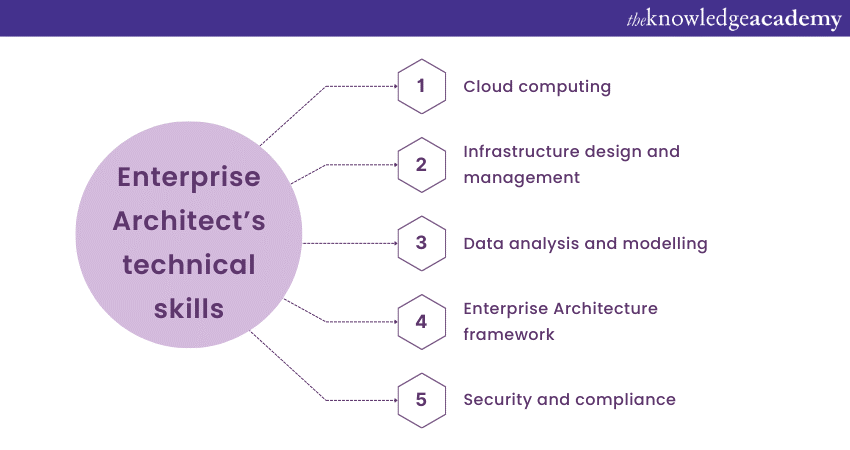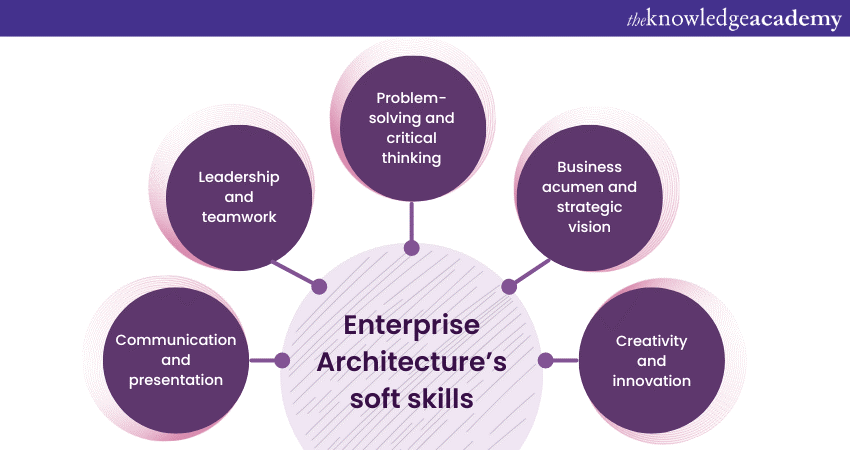We may not have the course you’re looking for. If you enquire or give us a call on +357 26030221 and speak to our training experts, we may still be able to help with your training requirements.
We ensure quality, budget-alignment, and timely delivery by our expert instructors.

Enterprise Architect Skills encompass diverse proficiencies crucial for shaping modern organisations' technological landscapes. Adept communication bridges the gap between technical complexity and stakeholders' understanding. Mastery of Architecture frameworks aids in designing robust solutions, while strategic thinking aligns technology with business goals. Proficiency in Cloud Computing, Security, and Data Management ensures seamless integration and protection of vital assets. Leadership and collaboration abilities facilitate guiding teams through intricate projects. Adapting to evolving trends and fostering innovation requires continuous learning. The synthesis of these Enterprise Architect Skills empowers architects to sculpt agile, future-ready infrastructures that drive success in today's dynamic business environment.
According to Bizzdesign, there has been 17% more demand for Enterprise Architects in recent years. Read this blog to understand the essential Enterprise Architect Skills in shaping innovative business strategies, technology landscapes, and organisational success.
Table of Contents
1) Who is an Enterprise Architect?
2) What Does an Enterprise Architect do?
3) Enterprise Architect Skills
a) Technical Skills
b) Soft Skills
4) Conclusion
Who is an Enterprise Architect?
Enterprise Architecture is a fascinating and rewarding career that combines technical expertise, strategic thinking, and creative vision. Enterprise Architects are the ones who shape the future of IT and business by aligning them with each other. They are responsible for aligning the business goals and strategies with the technology solutions and capabilities. They are also involved in planning, implementing, and managing the changes and transformations that affect the enterprise.
What Does an Enterprise Architect do?

An Enterprise Architect is a professional who designs and oversees an organisation's IT system and processes. They need to have both technical and business skills, as well as strategic vision and creativity. They must be able to design, implement, and manage a robust, reliable, secure, and efficient IT infrastructure that meets the current and future demands of the organisation. They also need to be able to communicate and collaborate with other stakeholders, such as business leaders, customers, vendors, and regulators, to ensure that the IT solution meet their requirements and expectations. Some of the typical responsibilities are:
a) Developing strategies, principles, and roadmaps in alignment with business strategies and objectives.
b) Budgetary, project, and program governance to those strategies, principles, and roadmaps.
c) Innovation, future product, and tech selection.
d) Creating and implementing the organisation’s overall IT strategy, including technology roadmaps, Enterprise Architecture frameworks, and IT governance models.
e) Analysing the organisation’s current IT infrastructure, identifying areas for improvement, and developing strategies to optimise its technology investments.
f) Designing and developing IT solutions that enable the organisation to achieve its goals.
g) Working with various technologies, such as cloud computing, data analysis, security
h) Creating and maintaining a technology roadmap that outlines how the organisation will achieve its goals over time.
i) Working closely with stakeholders from various departments to identify technology requirements and ensure that technology investments are aligned with the organisation’s strategic priorities.
j) Managing technology risks, ensuring compliance with releavant regulations and standards, evaluating modern technologies that can improve the organisation’s operations and performance.
Become a true architect in no time with our comprehensive, industry-leading curriculum. Join our Enterprise Architect Training now!
Enterprise Architect Skills
Enterprise Architecture is a complex and multidisciplinary field that requires various skills and competencies. Enterprise Architect skills can be broadly categorised into two types; technical skills and soft skills.
Technical Skills
Technical skills relate to the technical aspects of Enterprise Architecture, such as designing, implementing, and managing the IT systems and processes that support the business goals and strategies. They include:

a) Cloud Computing: It includes using and managing cloud services, such as servers, storage, databases, networking, software, analysis, and intelligence, over the internet. Cloud computing offers many benefits, such as scalability, flexibility, cost-efficiency, security, and innovation.
Enterprise Architects need to know how to leverage cloud computing to optimise their organisation’s IT performance and capabilities. To excel in this, they must be aware of the different types of cloud services, such as public, hybrid, and multi-cloud, and how to choose the best one for their organisation’s needs. Preparing with Enterprise Architect Interview Questions can also help them understand how these concepts are evaluated in professional scenarios.
For example, they may use a public cloud service like AWS or Azure to host their web applications and data warehouses, a private cloud service like VMware or OpenStack to run their internal systems and databases, a hybrid cloud service like Google Anthos or IBM Cloud Pak to integrate their on-premises and cloud environments, and a multi-cloud service like Cloudflare or HashiCorp to manage their network and security across multiple cloud providers.
b) Infrastructure Design and Management: It includes planning, building, operating, and maintaining the physical and virtual components of an IT system, such as hardware, software, networks, servers, devices, and platforms. Enterprise Architects must know how to design and manage a robust, reliable, secure, and efficient infrastructure that meets their organisation. They also need to be able to troubleshoot and resolve any issues in the infrastructure.
For example, an Enterprise Architect may use a private cloud service like VMware or OpenStack to run their internal systems and databases, a hybrid cloud service like Google Anthos or IBM Cloud Pak to integrate their on-premises and cloud environments.
c) Data Analysis and Modelling: It includes collecting, processing, analysing, and interpreting data to generate insights and support decision-making. Enterprise Architects Need to know how to use various data analysis and modelling techniques, such as statistics, machine learning, artificial intelligence, data mining, data visualisation, etc. To understand the data needs and opportunities of their organisation. They must also know how to design and implement data architectures that enable data integration, quality, security, governance, and accessibility.
For example, an Enterprise Architect may use a data analysis tool like R or Python to perform statistical and predictive analysis on their organisation's data, a data modelling tool like ERwin or PowerDesigners to create logical and physical data models that represent the data structures and relationships, a data visualisation tool like Tableau or Power BI to create interactive dashboards and reports that display the data insights, and a data architecture tool like Apache Kafka or Azure Data Factory to create data pipelines that move and transform the data from various sources to various destinations.
d) Enterprise Architecture Frameworks and Tools: it includes using standardised methodologies, models, languages, and tools to describe and document the structure, components, relationships, and principles of an IT system. It helps to create a common and consistent view of the IT landscape, as well as to guide and govern its design, development, and evolution.
For example, they may use an Enterprise Architecture framework like TOGAF to follow a structured process for developing and managing their organisation's IT architecture, a model like Zachman to define the different perspectives and dimensions of their IT architecture, language like ArchiMate to express the concepts and elements of their IT architecture in a graphical way, and tools like Sparx Enterprise Architect or BiZZdesign Enterprise Studio to create and maintain their IT architecture models and documents.
e) Security and Compliance: It includes ensuring that the IT systems and processes are protected from unauthorised access, use, modification, or damage, as well as complying with relevant laws, regulations, standards, and policies. Enterprise Architects need to know how to assess and mitigate the security risks and vulnerabilities of their organisation’s IT infrastructure and also to implement and monitor the security controls and measures that ensure its confidentiality, integrity, and availability. They also need to know how to comply with the legal and ethical requirements and obligations that apply to their organisation’s IT operations and activities.
For example, an Enterprise Architect may use a security framework like ISO 27001 or NIST Cybersecurity Framework to establish and implement a security management system for their IT environment.
Unleash your inner Integration Architect and dominate the digital world. Join our Integration Architect Training now!
Soft Skills
Soft skills relate to the interpersonal and communication aspects of Enterprise Architecture, such as working with and influencing various stakeholders, leading and collaborating with teams, solving problems, making decisions, and understanding and aligning with the business vision and strategy. Soft skills include:

a) Communication and Presentation: This is the skill of expressing and exchanging information clearly and effectively, verbally and in writing, with different audiences and purposes.
Enterprise Architects need to know how to communicate their ideas, plans, designs, and solutions to stakeholders, such as business leaders, customers, vendors, regulators, and peers. They also need to know how to present their work compellingly and convincingly, using various tools and techniques, such as slides, diagrams, charts, and graphs, which can be effectively demonstrated in an Enterprise Architect Resume to showcase strong communication and presentation skills.
For example, an Enterprise Architect may use a communication tool like Microsoft Teams or Slack to collaborate with their team members and share project updates and feedback. They may also use a presentation tool like PowerPoint or Prezi to create and deliver a presentation to their senior management or clients about the benefits and outcomes of their IT solutions.
b) Leadership and Teamwork: This is the skill of inspiring, motivating, and guiding others towards a common goal, as well as working cooperatively and harmoniously with others.
Enterprise Architects need to know how to lead and manage their teams effectively by setting clear expectations, providing direction and support, delegating tasks and responsibilities, resolving conflicts, and giving recognition and feedback. To Become an Enterprise Architect, they also need to know how to work well with other teams and departments across the organisation by building trust and rapport, respecting diversity and differences, sharing information and resources, and coordinating actions and efforts.
For example, an Enterprise Architect may use a leadership tool like Trello or Asana to organise and track their team's progress and project performance. They may also use a teamwork tool like Zoom or Google Meet to communicate and collaborate with other teams and stakeholders on their IT solutions.
c) Problem-solving and Critical Thinking: This is the skill of identifying, analysing, and solving problems logically and systematically, as well as evaluating the validity and reliability of information and arguments.
Enterprise Architects need to know how to solve complex and challenging problems in their IT systems and processes, by applying various methods and techniques, such as brainstorming, root cause analysis, design thinking, etc. They also need to know how to critically assess the information and arguments they encounter in their IT projects using various criteria and standards, such as relevance, accuracy, consistency, etc.
For example, an Enterprise Architect may use a problem-solving tool like Miro or Lucidchart to create diagrams and maps that help them visualise and understand their problems. They may also use a critical thinking tool like Socrative or Kahoot to test their knowledge and reasoning skills on their IT topics.
d) Business Acumen and Strategic Vision: This is the skill of understanding the business context and environment in which the IT systems and processes operate and developing a long-term vision and direction for the IT architecture that supports the business goals and strategies.
Enterprise Architects need to know how to align their IT solutions with their organisation's business needs and objectives by conducting various analyses and assessments, such as SWOT analysis, PEST analysis, gap analysis, etc. They must also know how to create a strategic vision and roadmap for their IT architecture that guides its design, development, and evolution.
For example, they may use a business analysis tool like Excel or Power Pivot to perform data analysis and calculations on their organisation's financial and operational data. They may also use a strategic vision tool like MindManager or XMind to create and communicate their IT architecture vision and roadmap to their stakeholders.
e) Creativity and Innovation: This is the skill of generating new and original ideas and solutions that add value and improve the IT systems and processes of the organisation.
Enterprise Architects need to know how to think creatively and innovatively by using various methods and techniques, such as brainstorming, prototyping, testing, etc. They also need to know how to foster a culture of creativity and innovation in their teams and organisations by encouraging experimentation, learning, feedback, and collaboration.
For example, they may use a creativity tool like Mural or Jamboard to brainstorm and sketch their ideas and solutions with their team members. They may also use an innovation tool like Lean Canvas or Business Model Canvas to test and validate their ideas and solutions with their customers and users.
Get ready to ace your integration architect interview! Study the most important Integration Architect Interview Questions and confidently tackle your next interview.
Conclusion
Enterprise Architect Skills is not just a technical skill; it is also a strategic skill that requires a lot of creativity, vision, and leadership. They are in high demand in today’s world, where technology constantly evolves and disrupts how we work and live. They are the ones who can help organisations adapt, innovate, and thrive in the digital age.
Unlock the world of enterprise integration today with our Enterprise Integration fundamentals course now!
Frequently Asked Questions
How Important is Knowledge of Cloud Computing for an Enterprise Architect?

Understanding cloud computing is important in an enterprise architect’s kit. By using it, they are able to create solutions that can scale while being the most cost-effective, as well as secure and compliant with business objectives. This is especially important as cloud adoption continues to happen consistently with organisations.
What Certifications are Beneficial for an Enterprise Architect?

Certifications like TOGAF, AWS Certified Solutions Architect, Microsoft Certified: Azure Solutions Architect, and Google Professional Cloud Architect are of great value to enterprise architects. They confirm knowledge of such frameworks, cloud, and IT strategies and contribute to the advancement of career opportunities.
What are the Other Resources and Offers Provided by The Knowledge Academy?

The Knowledge Academy takes global learning to new heights, offering over 3,000 online courses across 490+ locations in 190+ countries. This expansive reach ensures accessibility and convenience for learners worldwide.
Alongside our diverse Online Course Catalogue, encompassing 19 major categories, we go the extra mile by providing a plethora of free educational Online Resources like News updates, Blogs, videos, webinars, and interview questions. Tailoring learning experiences further, professionals can maximise value with customisable Course Bundles of TKA.
What is The Knowledge Pass, and How Does it Work?

The Knowledge Academy’s Knowledge Pass, a prepaid voucher, adds another layer of flexibility, allowing course bookings over a 12-month period. Join us on a journey where education knows no bounds.
What are the Related Courses and Blogs Provided by The Knowledge Academy?

The Knowledge Academy offers various Enterprise Architect Training, including the Integration Architect Training, Information Architect Training Course and the Enterprise Integration Fundamentals. These courses cater to different skill levels, providing comprehensive insights into Enterprise Architect Salary.
Our Business Improvement Blogs cover a range of topics related to Enterprise Architecture, offering valuable resources, best practices, and industry insights. Whether you are a beginner or looking to advance your Business Management Skills, The Knowledge Academy's diverse courses and informative blogs have got you covered.
Upcoming Business Improvement Resources Batches & Dates
Date
 Certified Enterprise Architect Professional (CEAP)
Certified Enterprise Architect Professional (CEAP)
Thu 15th May 2025
Thu 31st Jul 2025
Thu 30th Oct 2025






 Top Rated Course
Top Rated Course



 If you wish to make any changes to your course, please
If you wish to make any changes to your course, please


